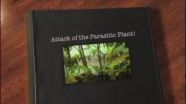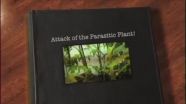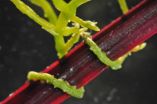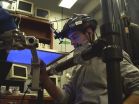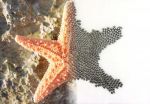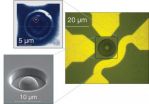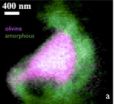(Press-News.org) VIDEO:
This time-lapse video shows how the parasitic plant dodder attacks tomatoes. But beyond stealing nutrients from the host plants, a Virginia Tech researcher has discovered that the two plants also...
Click here for more information.
A Virginia Tech scientist has discovered a potentially new form of plant communication, one that allows them to share an extraordinary amount of genetic information with one another.
The finding by Jim Westwood, a professor of plant pathology, physiology, and weed science in the College of Agriculture and Life Sciences, throws open the door to a new arena of science that explores how plants communicate with each other on a molecular level. It also gives scientists new insight into ways to fight parasitic weeds that wreak havoc on food crops in some of the poorest parts of the world.
His findings were published on Aug. 15 in the journal Science.
"The discovery of this novel form of inter-organism communication shows that this is happening a lot more than any one has previously realized," said Westwood, who is an affiliated researcher with the Fralin Life Science Institute. "Now that we have found that they are sharing all this information, the next question is, 'What exactly are they telling each other?'."
Westwood examined the relationship between a parasitic plant, dodder, and two host plants, Arabidopsis and tomatoes. In order to suck the moisture and nutrients out of the host plants, dodder uses an appendage called a haustorium to penetrate the plant. Westwood has previously broken new ground when he found that during this parasitic interaction, there is a transport of RNA between the two species. RNA translates information passed down from DNA, which is an organism's blueprint.
His new work expands this scope of this exchange and examines the mRNA, or messenger RNA, which sends messages within cells telling them which actions to take, such as which proteins to code. It was thought that mRNA was very fragile and short-lived, so transferring it between species was unimaginable.
But Westwood found that during this parasitic relationship, thousands upon thousands of mRNA molecules were being exchanged between both plants, creating this open dialogue between the species that allows them to freely communicate.
Through this exchange, the parasitic plants may be dictating what the host plant should do, such as lowering its defenses so that the parasitic plant can more easily attack it. Westwood's next project is aimed at finding out exactly what the mRNA are saying.
Using this newfound information, scientists can now examine if other organisms such a bacteria and fungi also exchange information in a similar fashion. His finding could also help solve issues of food scarcity.
"Parasitic plants such as witchweed and broomrape are serious problems for
legumes and other crops that help feed some of the poorest regions in
Africa and elsewhere," said Julie Scholes, a professor at the University
of Sheffield, U.K., who is familiar with Westwood's work but was not part
of this project. "In addition to shedding new light on host-parasite
communication, Westwood's findings have exciting implications for the
design of novel control strategies based on disrupting the mRNA
information that the parasite uses to reprogram the host."
Westwood said that while his finding is fascinating, how this is applied will be equally as interesting.
"The beauty of this discovery is that this mRNA could be the Achilles hill for parasites," Westwood said. “This is all really exciting because there are so many potential implications surrounding this new information."
INFORMATION:
Plants may use newly discovered language to communicate, Virginia Tech scientist discovers
The discovery throws open the door to a new arena of science that explores how plants communicate with each other on a molecular level
2014-08-14
ELSE PRESS RELEASES FROM THIS DATE:
Human contribution to glacier mass loss on the increase
2014-08-14
This news release is available in German.
The ongoing global glacier retreat causes rising sea-levels, changing seasonal water availability and increasing geo-hazards. While melting glaciers have become emblematic of anthropogenic climate change, glacier extent responds very slowly to climate changes. "Typically, it takes glaciers decades or centuries to adjust to climate changes," says climate researcher Ben Marzeion from the Institute of Meteorology and Geophysics of the University of Innsbruck. The global retreat of glaciers observed today started around the middle ...
Seven tiny grains captured by Stardust likely visitors from interstellar space
2014-08-14
Since 2006, when NASA's Stardust spacecraft delivered its aerogel and aluminum foil dust collectors to Earth, a team of scientists has combed through the collectors in search of rare, microscopic particles of interstellar dust.
The team now reports that they have found seven dust motes that probably came from outside our solar system, perhaps created in a supernova explosion millions of years ago and altered by eons of exposure to the extremes of space. They would be the first confirmed samples of contemporary interstellar dust.
"They are very precious particles," ...
Memories of errors foster faster learning
2014-08-14
Using a deceptively simple set of experiments, researchers at Johns Hopkins have learned why people learn an identical or similar task faster the second, third and subsequent time around. The reason: They are aided not only by memories of how to perform the task, but also by memories of the errors made the first time.
"In learning a new motor task, there appear to be two processes happening at once," says Reza Shadmehr, Ph.D., a professor in the Department of Biomedical Engineering at the Johns Hopkins University School of Medicine. "One is the learning of the motor ...
Harnessing the power of bacteria's sophisticated immune system
2014-08-14
Bacteria's ability to destroy viruses has long puzzled scientists, but researchers at the Johns Hopkins Bloomberg School of Public Health say they now have a clear picture of the bacterial immune system and say its unique shape is likely why bacteria can so quickly recognize and destroy their assailants.
The researchers drew what they say is the first-ever picture of the molecular machinery, known as Cascade, which stands guard inside bacterial cells. To their surprise, they found it contains a two-strand, unencumbered structure that resembles a ladder, freeing it to ...
Message to parents: Babies don't 'start from scratch'
2014-08-14
There's now overwhelming evidence that a child's future health is influenced by more than just their parents' genetic material, and that children born of unhealthy parents will already be pre-programmed for greater risk of poor health, according to University of Adelaide researchers.
In a feature paper called "Parenting from before conception" published in today's issue of the top international journal Science, researchers at the University's Robinson Research Institute say environmental factors prior to conception have more influence on the child's future than previously ...
A self-organizing thousand-robot swarm
2014-08-14
Cambridge, Mass. – August 14, 2014 – The first thousand-robot flash mob has assembled at Harvard University.
"Form a sea star shape," directs a computer scientist, sending the command to 1,024 little bots simultaneously via an infrared light. The robots begin to blink at one another and then gradually arrange themselves into a five-pointed star. "Now form the letter K."
The 'K' stands for Kilobots, the name given to these extremely simple robots, each just a few centimeters across, standing on three pin-like legs. Instead of one highly-complex robot, a "kilo" of robots ...
Molecular engineers record an electron's quantum behavior
2014-08-14
A team of researchers led by the University of Chicago has developed a technique to record the quantum mechanical behavior of an individual electron contained within a nanoscale defect in diamond. Their technique uses ultrafast pulses of laser light both to control the defect's entire quantum state and observe how that single electron state changes over time. The work appears in this week's online Science Express and will be published in print later this month in Science.
This research contributes to the emerging science of quantum information processing, which demands ...
Mysteries of space dust revealed
2014-08-14
The first analysis of space dust collected by a special collector onboard NASA's Stardust mission and sent back to Earth for study in 2006 suggests the tiny specks, which likely originated from beyond our solar system, are more complex in composition and structure than previously imagined.
The analysis, completed at a number of facilities including the U.S. Department of Energy's Lawrence Berkeley National Lab (Berkeley Lab) opens a door to studying the origins of the solar system and possibly the origin of life itself.
"Fundamentally, the solar system and everything ...
New Milky Way maps help solve stubborn interstellar material mystery
2014-08-14
An international team of sky scholars, including a key researcher from Johns Hopkins, has produced new maps of the material located between the stars in the Milky Way. The results should move astronomers closer to cracking a stardust puzzle that has vexed them for nearly a century.
The maps and an accompanying journal article appear in the Aug. 15 issue of the journal Science. The researchers say their work demonstrates a new way of uncovering the location and eventually the composition of the interstellar medium—the material found in the vast expanse between star systems ...
CF mucus defect present at birth
2014-08-14
VIDEO:
This is a 3-D reconstruction from time-lapse CT-scans of a CF pig lung. Images show the trachea and bronchi. Colored round dots represent positions of particles that were...
Click here for more information.
Mucus is key to keeping our lungs clean and clear of bacteria, viruses, and other foreign particles that can cause infection and inflammation. When we inhale microbes and dust, they are trapped in the mucus and then swept up and out of the lungs via a process called ...
LAST 30 PRESS RELEASES:
Air pollution exposure and birth weight
Obstructive sleep apnea risk and mental health conditions among older adults
How talking slows eye movements behind the wheel
The Ceramic Society of Japan’s Oxoate Ceramics Research Association launches new international book project
Heart-brain connection: international study reveals the role of the vagus nerve in keeping the heart young
Researchers identify Rb1 as a predictive biomarker for a new therapeutic strategy in some breast cancers
Survey reveals ethical gaps slowing AI adoption in pediatric surgery
Stimulant ADHD medications work differently than thought
AI overestimates how smart people are, according to HSE economists
HSE researchers create genome-wide map of quadruplexes
Scientists boost cell "powerhouses" to burn more calories
Automatic label checking: The missing step in making reliable medical AI
Low daily alcohol intake linked to 50% heightened mouth cancer risk in India
American Meteorological Society announces Rick Spinrad as 2026 President-Elect
Biomass-based carbon capture spotlighted in newly released global climate webinar recording
Illuminating invisible nano pollutants: advanced bioimaging tracks the full journey of emerging nanoscale contaminants in living systems
How does age affect recovery from spinal cord injury?
Novel AI tool offers prognosis for patients with head and neck cancer
Fathers’ microplastic exposure tied to their children’s metabolic problems
Research validates laboratory model for studying high-grade serous ovarian cancer
SIR 2026 delivers transformative breakthroughs in minimally invasive medicine to improve patient care
Stem Cell Reports most downloaded papers of 2025 highlight the breadth and impact of stem cell research
Oxford-led study estimates NHS spends around 3% of its primary and secondary care budget on the health impacts of heat and cold in England
A researcher’s long quest leads to a smart composite breakthrough
Urban wild bees act as “microbial sensors” of city health.
New study finds where you live affects recovery after a hip fracture
Forecasting the impact of fully automated vehicle adoption on US road traffic injuries
Alcohol-related hospitalizations from 2016 to 2022
Semaglutide and hospitalizations in patients with obesity and established cardiovascular disease
Researchers ‘listen in’ to embryo-mother interactions during implantation using a culture system replicating the womb lining
[Press-News.org] Plants may use newly discovered language to communicate, Virginia Tech scientist discoversThe discovery throws open the door to a new arena of science that explores how plants communicate with each other on a molecular level
